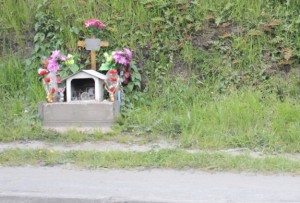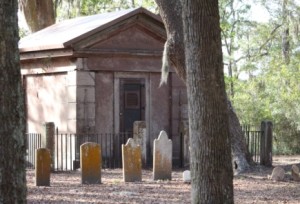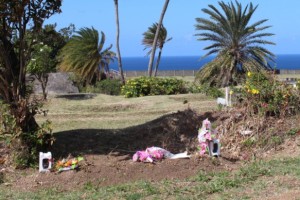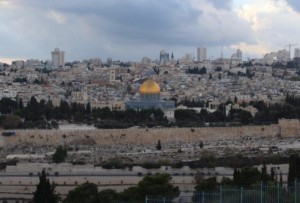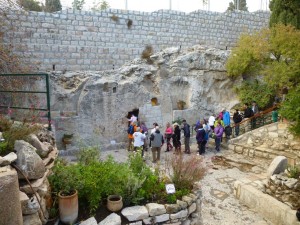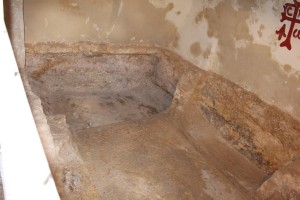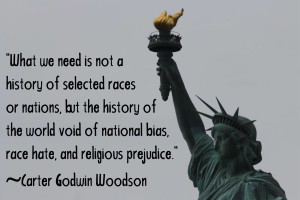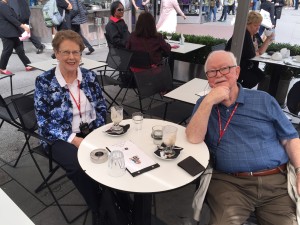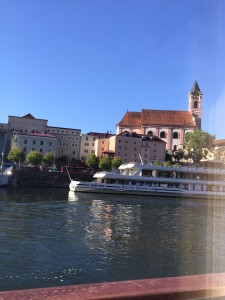Tuesday, April 5: Our group gathered in the hotel lobby for a visit to a predominately Maori school, Kaitao Middle School in Rotorua. Kaitao is a recipient of Grand Circle Travel donations. Roger again acted as our chief for purposes of introductions. A few selected students and staff welcomed each of us with the traditional Maori greeting. The Maoris greet a person by shaking right hands while placing the left hand on the person’s right shoulder and leaning forward touching foreheads to breathe in the person’s essence. The students sang a Maori song for us and we sang God Bless America for them. This school’s philosophy is to create a positive atmosphere for their students encouraging them to embrace their culture and to learn about others.
After a scenic drive to Auckland, we had a casual late lunch at Sal’s Authentic NY Pizza pizzeria. While there, a game on their TV attracted our attention. The NCAA Basketball Championship game between Villanova and North Carolina was in its final half. The game was so exciting that we didn’t want to leave. We ordered more pizza and cheered on whichever team we favored. The commotion we made prompted people walking past the small pizzeria to peek in. The teams were tied at 74 with less than a second to go. It looked like overtime would decide the winner. Suddenly the place inside and out erupted into loud cheers when Kris Jenkins’ three-pointer with four-tenths of a second remaining won the game for Villanova. Final score 77 to 74. What a great unexpected addition to our trip. We returned to the hotel and relaxed on our own for the rest of the day.
Wednesday, April 6: The first activity of the day for half the group was to sail on the Pride of the Sail in Auckland Harbour. The boat was operated by Brad at the helm and Brook as his assistant. What fun we each had taking our turn at the helm. Afterward, our half of the group exchanged places with the others and enjoyed a Harbour City Walk. An alternate option was a visit to the Maritime Museum.
The coach then took the entire group on a two-hour site seeing tour of Auckland. Our farewell dinner at the hotel was spectacular and delicious. A member of our group asked Roger to read aloud a prayer expressing her appreciation for the warm friendship of her fellow travelers and her wonderful experience on the trip. I couldn’t help but shed a few tears at her heartfelt words. Another member wrote a beautiful poem about our fun group and her great experience on the trip. We ended with hugs, kisses, and promises to try to keep in touch. This farewell dinner gave us a chance to say goodbye to those who were leaving this portion of the tour to return home while the rest of us continued for a few more days of travel.
Thursday, April 7: On our way to the Bay of Islands, we stopped at an impressive bird sanctuary run by a man and his wife. We learned about the kiwi, the national bird of New Zealand. Other birds also were housed there. In their one-room museum, we saw many pictures of birds, several stuffed birds, and pictures from visiting students illustrating what they learned at the sanctuary.
After our stop, we continued on the scenic ride to Copthorne Hotel and Resort in Paihia. Dinner at the hotel was followed by a relaxing evening where some of the remaining members of the tour group sat on the porch to socialize while overlooking the Bay of Islands.
Friday, April 8: At the wharf at Paihia, we boarded the Hole in the Rock Cruise boat. During the cruise, we saw about twenty playful bottlenose dolphins and other wildlife. The weather cooperated and we were able to cruise through the hole in the rock, a fascinating rock formation at the entrance to the Bay of Islands. On the return trip, Roger and some others climbed to the highest point on one of the islands from which they had a beautiful 360-degree panoramic view of the Bay of Islands. We stopped for lunch in the historical quaint town of Russell. We cruised back to the wharf, did a little site seeing, and later had an evening meal on our own.
Saturday, April 9: In the morning, our group took a guided tour of the Waitangi Treaty Grounds. That afternoon Roger and a friend played golf at the nearby course overlooking the Bay of Islands. Some people went to the waterfall, while the rest of us relaxed at the hotel.
Our dinner meal at the Only Seafood Restaurant on the stunning Paihia waterfront was delicious. Ronan and Roger ate green-lipped mussels in curry sauce. They were a sight to behold sucking the mussels from the shells and licking the dripping sauce from their fingers. The rest of us dined on less messy, but still tasty seafood.
Sunday, April 10: We loaded our packed bags on the coach for our return to Auckland. On the way, we stopped at the Glow Worms Cave for a tour. A few of us opted not to take that tour which included lots of descending stairs. We remained on the bus and socialized. Our next stop was the Jet Park Airport Hotel where we stayed in preparation for a 4:10 am departure the next morning. We had our dinner meal at the hotel and slept for a few hours.
Monday, April 11: Check-out time came much too early for this night owl. We took the shuttle bus to the airport. Ronan flew with us to Sydney, his hometown, and reminded us that we had to set our watches back two hours. Qantas served a satisfying hot breakfast on the flight to Sydney.
The crazy saga of our return home began when the Qantas flight was well over an hour late departing the Sydney Airport due to some mechanical problem. Not a very comforting announcement to hear. Roger said with that delay we might miss our Delta flight out of Los Angeles. After about 15 hours of flying, we arrived at the zoo, I mean, L. A. Airport, to retrieve our bags. We found numerous long lines at immigration. There were only two people handling the line we were in and one left for a break. Grrrr! Passengers in other lines who were behind us got through faster than we did.
Finally, another immigration agent arrived to process us. From immigration, we walked forever to the curbside Delta check-in. A couple of ladies in front of us gave the skycap a hard time about paying for their overweight luggage delaying us even more. Upon reaching the front of the check-in line, the skycap said that we were one minute too late to get checked in. The machine locked the skycap out. He hurried inside to find someone who could override the machine. This took another 10 minutes. Our plane was scheduled to depart at 9:20 am and it was already 8:45. His supervisor overrode the machine to check us in and gave us boarding passes.
Usually we go through the faster TSA line, however, our boarding passes didn’t indicate TSA pre-check. So we were directed to the regular, longer security line. Ugh. It was now 8:58. I did as the man at security suggested and politely asked to take cuts from people ahead of us who had later flights. They all said yes. This cut a couple of minutes off our time in the security line. Fortunately, my knee and hip replacements didn’t set off the machine. Yea!
It was about 9:09 when we finished. Roger grabbed his shoes and ran in sock feet to the gate a short distance from security. I can’t run, but I did a very fast walk to the gate with untied shoes. We arrived at the gate at 9:14. Luckily we were allowed to board only because they were still boarding a few other passengers. Apparently, that plane was also a little late. Thank goodness. I settled into my seat, exhausted, but grateful that we didn’t miss the Delta flight home.
The craziness of our flight out of Sydney and the delays at the LA Airport did not distract from our wonderful learning experience in Australia and New Zealand. I can’t thank my husband enough for adding this trip to my bucket list. We can’t wait for our next travel adventure.

